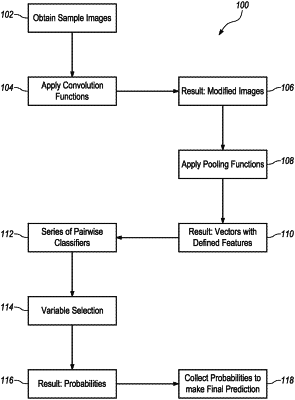| CPC G06T 7/0004 (2013.01) [G06F 18/2415 (2023.01); G06F 18/2431 (2023.01); G06N 5/04 (2013.01); G06N 20/00 (2019.01); G06V 10/454 (2022.01); G06V 10/764 (2022.01); G06V 10/82 (2022.01); G06T 2207/20076 (2013.01); G06T 2207/30148 (2013.01)] | 20 Claims |

|
1. A method comprising:
obtaining a first plurality of sample images of semiconductor wafers formed on a semiconductor substrate, the first plurality of sample images including a plurality of different image types;
applying at least a first convolution function to each of the first plurality of images to generate a plurality of modified images each corresponding to a respective one of the plurality of sample images;
applying a pooling function to each of the modified images to form a plurality of corresponding vectors each defining a plurality of features for each respective modified image;
performing variable selection on each corresponding vector in order to select a smaller set of features from the plurality of features that are more important in determining image type for the vector;
processing each corresponding vector in a plurality of machine-learning-based pairwise classifier models, each of the pairwise classifier models configured to determine a corresponding probability that the vector is more like one of unique plurality of pairs of the plurality of different image types;
inputting the determined probabilities from the processing step into a final machine-learning-based classifier model configured to assign one of the plurality of image types to each corresponding, vector on the basis of the determined probabilities from the processing step; and
running the final machine-learning-based classifier model.
|